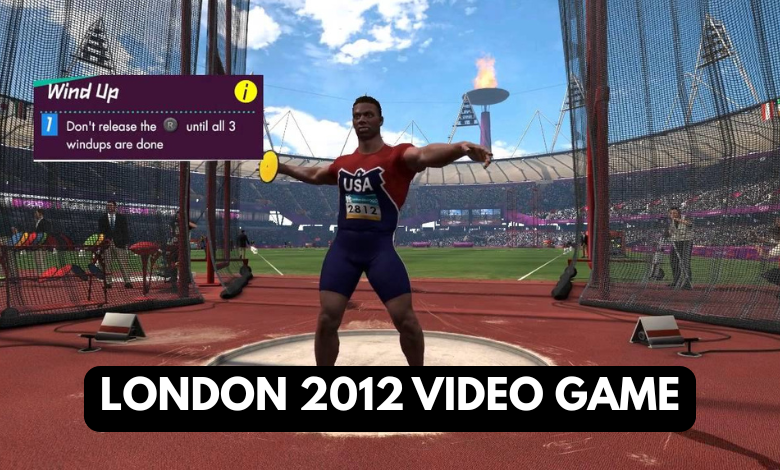London 2012 video game: The Official Video Game – A Complete Review, History, and Legacy

When people talk about sports games, titles like FIFA, NBA 2K, or Mario & Sonic usually come to mind. But in 2012, Sega released something different — a game that celebrated the Olympic spirit in a realistic, accessible way. London 2012: The Official Video Game wasn’t just another sports simulator. It captured the excitement of the London Olympics and gave players a chance to represent their country from their living room.
For many of us, this game was a nostalgic trip. It came out at a time when gaming was shifting from the couch to online multiplayer. Whether you played it on PC, Xbox 360, or PlayStation 3, the moment you started sprinting down the track or diving from the 10-meter platform, you could feel the energy of the Olympics. Even now, years later, players still revisit it — partly for the memories, and partly because no other game has recreated that specific Olympic magic.
2. Game Overview
Developed by Sega Studios Australia and published by Sega, London 2012: The Official Video Game of the Olympic Games launched in mid-2012. It was available on PC, PlayStation 3, and Xbox 360, with mobile versions later developed by Neowiz for iOS and Android.
This was not Sega’s first Olympic title, but it was arguably their most polished. The game came out just before the London Summer Olympics began, letting fans experience the events virtually before watching them live on TV. Sega had exclusive Olympic licensing rights at the time, which allowed them to include official stadiums, branding, and national teams.
One of the game’s biggest strengths was its range of modes. You could play single events, full Olympic campaigns, or even multiplayer tournaments. Players could choose from over 200 nations and compete for medals in 31 events. There was also a “National Pride” leaderboard that ranked countries globally based on players’ medals — a clever way to turn individual performance into a community challenge.
3. Events and Gameplay
3.1 Variety of Events
The heart of London 2012 lay in its events. Sega didn’t settle for a few mini-games. They offered a full Olympic experience, spread across multiple categories:
Track & Field: 100m sprint, 200m sprint, hurdles, javelin, triple jump, and shot put.
Aquatics: 3m springboard, 10m platform diving, and 100m freestyle swimming.
Shooting: Skeet, rapid fire pistol, and archery.
Gymnastics: Trampoline, rings, and vault.
Other Sports: Canoe slalom, cycling keirin, weightlifting, table tennis, and beach volleyball.
Each event required a different rhythm and control style. For example, sprinting relied on rapid button presses for speed, while diving and gymnastics focused on timing and precision. This variety kept the gameplay fresh and tested more than just reflexes — it demanded coordination and focus.
3.2 Controls and Mechanics
Controls were straightforward yet unforgiving. On PC, you could use a keyboard or controller, but the latter offered smoother input. On consoles, motion controls through Kinect or PlayStation Move added immersion, though accuracy could be inconsistent.
Events like javelin or discus needed you to balance speed and timing, while shooting and archery required a steady hand. The button combinations were easy to learn but difficult to master, especially in competitive play.
Even after a decade, the control design still holds up. It rewards practice and rhythm instead of random button mashing. Many players found themselves improving gradually — just like real athletes.
3.3 Presentation and Realism
Visually, London 2012 looked impressive for its time. The stadiums were modeled after real Olympic venues. Lighting, crowd reactions, and commentary gave it an authentic broadcast feel. Sega managed to make every event look cinematic without losing playability.
The national uniforms, flags, and medal ceremonies were recreated with care. Hearing your country’s anthem after winning gold was surprisingly satisfying. It’s that small attention to detail that made players feel connected to the Olympics themselves.
4. Multiplayer, Online Features, and Community
The multiplayer mode was one of the biggest draws. London 2012 allowed up to four local players on a single console, or online competitions with players worldwide. Online leaderboards tracked medals and contributed to the “National Pride” system, where each country’s total medals affected its global ranking.
It wasn’t perfect — matchmaking could be slow, and the player base wasn’t huge even at launch. But for those who found regular opponents, it offered great replay value. Competing against real players added unpredictability that AI opponents couldn’t match.
The community also shared unofficial events and challenges online, like custom mini-tournaments or national contests. While the official servers have long been inactive, fans occasionally organize community play sessions through emulators or backward compatibility.
Even after its delisting from Steam, the community on forums and Reddit continues to share fixes, gameplay clips, and nostalgic stories. It’s a small but dedicated group of players who keep the Olympic spirit alive digitally.
5. Reception and Critique
When London 2012 launched, reviews were mixed but leaned positive. Critics on Metacritic gave it average to above-average scores, usually between 65 and 75 out of 100.
Praise:
-
Wide variety of events
-
Fun and competitive multiplayer
-
Strong visual presentation for the era
-
Sense of national pride and Olympic atmosphere
Criticism:
-
Shallow single-player progression
-
Uneven controls on PC
-
Repetitive button mechanics in some events
-
Lack of athlete customization
Personally, I remember critics being a bit harsh on it, probably because they compared it to deeper sports sims like FIFA. But that’s not a fair comparison. London 2012 wasn’t trying to be a year-round sports franchise. It was a celebration — a limited-time event that captured the excitement of one historic summer. And it did that remarkably well.
6. Challenges in Access and Preservation
One unfortunate truth about licensed games is that they rarely stay available for long. London 2012 was delisted from Steam and digital stores a few years after release due to expired Olympic licenses. Physical copies are now collector’s items, often selling for high prices online.
If you already own the game, you can still play it on modern PCs through compatibility tweaks. Community forums have guides for running it smoothly on Windows 10 and 11. For consoles, backward compatibility depends on your region and console version. Xbox 360 discs work on some newer Xbox systems, but PS3 copies remain locked to older hardware.
These licensing issues raise bigger questions about video game preservation. Should historical sports games be lost because of temporary contracts? Many players believe that titles like London 2012 should be archived, at least for cultural and historical purposes.
Until that happens, the only way to relive the experience is through second-hand discs or archived gameplay footage on YouTube.
7. Comparison with Other Olympic Games
The main comparison everyone makes is between London 2012: The Official Video Game and Mario & Sonic at the London 2012 Olympic Games. Both released around the same time, both had the same setting, but they couldn’t be more different.
Mario & Sonic took an arcade approach — fun, colorful, and cartoonish. London 2012, on the other hand, aimed for realism. It wasn’t about mascots or power-ups. It was about replicating the real Olympic feeling. While Mario & Sonic was great for families, London 2012 appealed to players who wanted skill-based competition and realistic graphics.
Compared to earlier Olympic games like Beijing 2008, London 2012 improved almost everything — smoother controls, more events, and a better visual engine. Later games, like Tokyo 2020, never reached the same level of critical or fan enthusiasm.
8. Tips and Strategies for Players
If you ever get the chance to play London 2012 again, here are a few tips that still hold up:
-
Master timing, not speed. In sprinting events, button mashing only gets you so far. Learn when to press for rhythm and when to conserve stamina.
-
Start with your best events. Everyone finds certain sports more intuitive. For most beginners, swimming, archery, and table tennis are great starting points.
-
Watch the AI patterns. Many events, like diving and gymnastics, are about precision. Observe AI routines to understand scoring patterns.
-
Use a controller. Keyboard input can feel stiff. Controllers offer smoother analog control, especially for aiming or steering events.
-
Don’t ignore National Pride. Competing online may not seem rewarding now, but contributing to your country’s stats was one of the game’s most fun community elements.
Small habits, like steady breathing and patience during precision events, can make a noticeable difference — something that mirrors real athletic performance.
9. Personal Reflections and Legacy
For me, London 2012 is more than just a video game. It’s a time capsule of 2012 — the music, the Olympic fever, and the collective excitement around sports. I remember playing it during the actual Olympics, switching between the game and TV broadcasts. It created a sense of connection, like being part of something global.
Even though it’s been more than a decade, I still believe London 2012 is the best Olympic game ever made. It struck the right balance between accessibility and challenge. It respected the real athletes but still offered a fun, engaging experience for everyone.
Games like this remind us why sports and gaming mix so well. They’re about competition, improvement, and community — all universal human traits.
If you find a copy today, it’s worth keeping. Not just to play, but to preserve a small part of gaming and Olympic history.
10. Conclusion
London 2012: The Official Video Game may not have the lasting fame of FIFA or NBA 2K, but it achieved something few games do — it made people feel like Olympians, even for a few minutes. Sega’s attention to detail, the range of events, and the competitive spirit turned it into an experience that still stands out.
Its delisting from stores is a reminder that great games can disappear quietly. But among those who played it, London 2012 remains a symbol of sportsmanship, nostalgia, and national pride. Whether you played for fun or chased gold medals seriously, it’s a game that deserves to be remembered.
11. Frequently Asked Questions (FAQ)
Q1: Is London 2012: The Official Video Game still available?
No, it was delisted from Steam and digital stores due to expired Olympic licenses. You can only find physical copies on resale platforms.
Q2: Which platform is best for playing it today?
The Xbox 360 and PS3 versions still run well if you have original hardware. On PC, you may need compatibility tweaks, but it’s playable.
Q3: How many events are in the game?
There are 31 playable events covering athletics, aquatics, gymnastics, shooting, and more.
Q4: Does it still support online multiplayer?
Official servers are no longer active, but local multiplayer works fine. Some players use LAN or emulator setups to recreate online play.
Q5: Is it better than Mario & Sonic at the London 2012 Olympic Games?
They serve different audiences. Mario & Sonic is arcade-style fun, while London 2012 is realistic and skill-based. Many players prefer the latter for its authenticity.
Final Thoughts
London 2012: The Official Video Game is a forgotten gem that deserves more recognition. It combined sportsmanship, competition, and nostalgia in a way few titles ever have. Whether you’re revisiting it for old times’ sake or discovering it for the first time, it still offers pure, uncomplicated joy — the kind that made gaming special in the first place.



